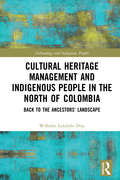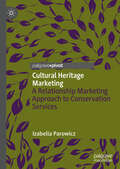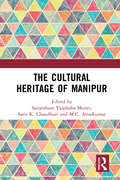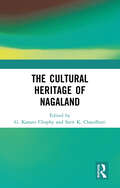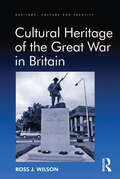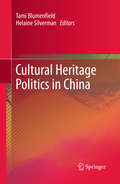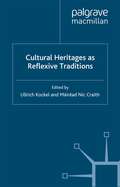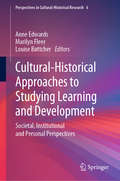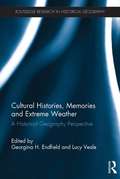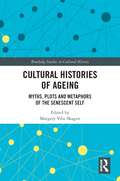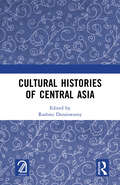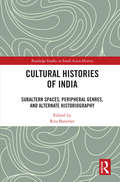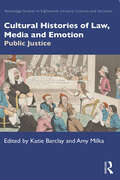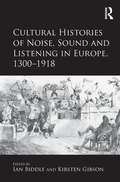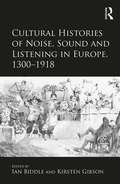- Table View
- List View
Cultural Heritage Management and Indigenous People in the North of Colombia: Back to the Ancestors' Landscape (Archaeology and Indigenous Peoples)
by Wilhelm Londoño DíazCultural Heritage Management and Indigenous People in the North of Colombia explores indigenous people's struggle for territorial autonomy in an aggressive political environment and the tensions between heritage tourism and Indigenous rights. South American cases where local communities, especially Indigenous groups, are opposed to infrastructure projects, are little known. This book lays out the results of more than a decade of research in which the resettlement of a pre-Columbian village has been documented. It highlights the difficulty of establishing the link between archaeological sites and objects, and Indigenous people due to legal restrictions. From a decolonial framework, the archaeology of Pueblito Chairama (Teykú) is explored, and the village stands as a model to understand the broader picture of the relationship between Indigenous people and political and economic forces in South America. The book will be of interest to researchers in Archaeology, Anthropology, Heritage and Indigenous Studies who wish to understand the particularities of South American repatriation cases and Indigenous archaeology in the region.
Cultural Heritage Marketing: A Relationship Marketing Approach to Conservation Services
by Izabella ParowiczProviding an overview of the marketing principles and tools that pertain to the area of heritage conservation services, this book combines research and practice to offer an alternative to the classical transactional marketing approach. Instead, the author argues for the relationship marketing approach, promoted and adopted by the Nordic School of Service Marketing. Offering a startlingly rare, but logical and practical marketing approach, this book also provides food for thought for academics dealing with managerial and marketing aspects in the field of cultural heritage and cultural heritage services.
The Cultural Heritage of Manipur
by S. Yaiphaba MeiteiThe Indira Gandhi Rashtriya Manav Sangrahalaya, Bhopal has a project to map the cultural heritage of North-East India. One volume is planned on each state. Manipur is one of the unique multi-ethnic states of North-East India which has a complex but distinctive cultural heritage of its own. This book presents the different facets of the cultural heritage of the border state of Manipur ingrained within its historicity, identity and political ecology. This book will be of much value for scholars across the disciplinary frames and pave the way for further research. Please note: Taylor & Francis does not sell or distribute the Hardback in India, Pakistan, Nepal, Bhutan, Bangladesh and Sri Lanka.
The Cultural Heritage of Manipur
by Sanjenbam Yaiphaba Meitei Sarit K. Chaudhuri M. C. ArunkumarThe Indira Gandhi Rashtriya Manav Sangrahalaya, Bhopal has a project to map the cultural heritage of North-East India. One volume is planned on each state. Manipur is one of the unique multi-ethnic states of North-East India which has a complex but distinctive cultural heritage of its own. This book presents the different facets of the cultural heritage of the border state of Manipur ingrained within its historicity, identity and political ecology. This book will be of much value for scholars across the disciplinary frames and pave the way for further research. Please note: Taylor & Francis does not sell or distribute the Hardback in India, Pakistan, Nepal, Bhutan, Bangladesh and Sri Lanka.
The Cultural Heritage of Nagaland
by G. Kanato Chophy Sarit K. ChaudhuriThis volume gives an in-depth account of cultural heritage of Nagaland covering important themes like cultural beliefs, traditional knowledge, material culture, and social institutions. Contributors from diverse disciplines and backgrounds have delved into the cultural heritage of the state’s variegated tribes. Nagaland a hilly state in North-East India had been the centre of British colonialism and American Baptist mission. This cultural contact is significantly reflected in the socio-cultural life, and the contributors have shed light on the continuities and changes. This volume highlights the multiplicity of cultural traditions that are specific to various tribes inhabiting sixteen districts of Nagaland, since their experiences of modernity and cultural contact with ‘others’ have been diverse. The contributors have mainly focussed on the cultural heritage of the majority Naga tribes, but other tribes like the Kukis and Kacharis are part and parcel of the cultural melting pot of Nagaland, and this volume in a way underscores the cultural exchange and interactions. Taylor & Francis does not sell or distribute the print version of this book in India, Pakistan, Nepal, Bhutan, Bangladesh and Sri Lanka.
The Cultural Heritage of Nagaland
by G. Kanato Chophy Sarit K. ChaudhuriThis volume gives an in-depth account of cultural heritage of Nagaland covering important themes like cultural beliefs, traditional knowledge, material culture, and social institutions. Contributors from diverse disciplines and backgrounds have delved into the cultural heritage of the state’s variegated tribes. Nagaland a hilly state in North-East India had been the centre of British colonialism and American Baptist mission. This cultural contact is significantly reflected in the socio-cultural life, and the contributors have shed light on the continuities and changes. This volume highlights the multiplicity of cultural traditions that are specific to various tribes inhabiting sixteen districts of Nagaland, since their experiences of modernity and cultural contact with ‘others’ have been diverse. The contributors have mainly focussed on the cultural heritage of the majority Naga tribes, but other tribes like the Kukis and Kacharis are part and parcel of the cultural melting pot of Nagaland, and this volume in a way underscores the cultural exchange and interactions. Taylor & Francis does not sell or distribute the print version of this book in India, Pakistan, Nepal, Bhutan, Bangladesh and Sri Lanka.
Cultural Heritage of the Great War in Britain (Heritage, Culture and Identity)
by Ross J. WilsonAs the hundredth anniversary approaches, it is timely to reflect not only upon the Great War itself and on the memorials which were erected to ensure it did not slip from national consciousness, but also to reflect upon its rich and substantial cultural legacy. This book examines the heritage of the Great War in contemporary Britain. It addresses how the war maintains a place and value within British society through the usage of phrases, references, metaphors and imagery within popular, media, heritage and political discourse. Whilst the representation of the war within historiography, literature, art, television and film has been examined by scholars seeking to understand the origins of the 'popular memory' of the conflict, these analyses have neglected how and why wider popular debate draws upon a war fought nearly a century ago to express ideas about identity, place and politics. By examining the history, usage and meanings of references to the Great War within local and national newspapers, historical societies, political publications and manifestos, the heritage sector, popular expressions, blogs and internet chat rooms, an analysis of the discourses which structure the remembrance of the war can be created. The book acknowledges the diversity within Britain as different regional and national identities draw upon the war as a means of expression. Whilst utilising the substantial field of heritage studies, this book puts forward a new methodology for assessing cultural heritage and creates an original perspective on the place of the Great War across contemporary British society.
Cultural Heritage of the Great War in Britain (Heritage, Culture and Identity)
by Ross J. WilsonAs the hundredth anniversary approaches, it is timely to reflect not only upon the Great War itself and on the memorials which were erected to ensure it did not slip from national consciousness, but also to reflect upon its rich and substantial cultural legacy. This book examines the heritage of the Great War in contemporary Britain. It addresses how the war maintains a place and value within British society through the usage of phrases, references, metaphors and imagery within popular, media, heritage and political discourse. Whilst the representation of the war within historiography, literature, art, television and film has been examined by scholars seeking to understand the origins of the 'popular memory' of the conflict, these analyses have neglected how and why wider popular debate draws upon a war fought nearly a century ago to express ideas about identity, place and politics. By examining the history, usage and meanings of references to the Great War within local and national newspapers, historical societies, political publications and manifestos, the heritage sector, popular expressions, blogs and internet chat rooms, an analysis of the discourses which structure the remembrance of the war can be created. The book acknowledges the diversity within Britain as different regional and national identities draw upon the war as a means of expression. Whilst utilising the substantial field of heritage studies, this book puts forward a new methodology for assessing cultural heritage and creates an original perspective on the place of the Great War across contemporary British society.
Cultural Heritage Politics in China
by Tami Blumenfield and Helaine SilvermanThis volume explores China’s cultural heritage ideology and policies from three interrelated perspectives: the State and World Heritage tourism; cultural heritage tourism at undesignated sites, and the cultural politics of museums and collections. Something of a cultural heritage designation craze is happening in China. This is new within even the last five to ten years. Officials at many levels now see heritage preservation as a means for commoditizing their regions. They are devoting new resources and attention to national and international heritage designations. Thus, addressing cultural heritage politics in a nation dedicated to designation is an important project, particularly in the context of a rapidly growing economy. This volume is also important because it addresses a very wide range of cultural heritage, providing an excellent sample of case studies: historic vernacular urban environments, ethnic tourism, scenic tourism, pilgrimage as tourism, tourism and economic development, museums, border heritage, underwater remains, and the actual governance and management of the sites. This volume is an outstanding introduction to cultural heritage issues in China while contributing to Chinese studies for those with greater knowledge of the area.
Cultural Heritages as Reflexive Traditions
by U. Kockel M. Nic Craith Máiréad Nic CraithDrawing on anthropological fieldwork, this book presents case studies illustrating the re-conceptualization of heritages and traditions in selected locations in Africa, Asia, Australia and Europe. The authors review the importance of oral traditions as markers of identity and consider competing narratives of heritage in postcolonial societies.
Cultural-Historical Approaches to Studying Learning and Development: Societal, Institutional and Personal Perspectives (Perspectives in Cultural-Historical Research #6)
by Anne Edwards Marilyn Fleer Louise BøttcherThis collection of papers examines key ideas in cultural-historical approaches to children’s learning and development and the cultural and institutional conditions in which they occur. The collection is given coherence by a focus on the intellectual contributions made by Professor Mariane Hedegaard to understandings of children’s learning through the prism of the interplay of society, institution and person. She has significantly shaped the field through her scholarly consideration of foundational concepts and her creative attention to the fields of activity she studies. The book brings together examples of how these concepts have been employed and developed in a study of learning and development. The collection allows the contributing scholars to reveal their reactions to Hedegaard’s contributions in discussions of their own work in the field of children’s learning and the conditions in which it occurs.
Cultural Histories, Memories and Extreme Weather: A Historical Geography Perspective (Routledge Research in Historical Geography)
by Georgina H. Endfield Lucy VealeExtreme weather events, such as droughts, strong winds and storms, flash floods and extreme heat and cold, are among the most destructive yet fascinating aspects of climate variability. Historical records and memories charting the impacts and responses to such events are a crucial component of any research that seeks to understand the nature of events that might take place in the future. Yet all such events need to be situated for their implications to be understood. This book is the first to explore the cultural contingency of extreme and unusual weather events and the ways in which they are recalled, recorded or forgotten. It illustrates how geographical context, particular physical conditions, an area’s social and economic activities and embedded cultural knowledges and infrastructures all affect community experiences of and responses to unusual weather. Contributions refer to varied methods of remembering and recording weather and how these act to curate, recycle and transmit extreme events across generations and into the future. With international case studies, from both land and sea, the book explores how and why particular weather events become inscribed into the fabric of communities and contribute to community change in different historical and cultural contexts. This is valuable reading for students and researchers interested in historical and cultural geography, environmental anthropology and environmental studies.
Cultural Histories, Memories and Extreme Weather: A Historical Geography Perspective (Routledge Research in Historical Geography)
by Georgina H. Endfield Lucy VealeExtreme weather events, such as droughts, strong winds and storms, flash floods and extreme heat and cold, are among the most destructive yet fascinating aspects of climate variability. Historical records and memories charting the impacts and responses to such events are a crucial component of any research that seeks to understand the nature of events that might take place in the future. Yet all such events need to be situated for their implications to be understood. This book is the first to explore the cultural contingency of extreme and unusual weather events and the ways in which they are recalled, recorded or forgotten. It illustrates how geographical context, particular physical conditions, an area’s social and economic activities and embedded cultural knowledges and infrastructures all affect community experiences of and responses to unusual weather. Contributions refer to varied methods of remembering and recording weather and how these act to curate, recycle and transmit extreme events across generations and into the future. With international case studies, from both land and sea, the book explores how and why particular weather events become inscribed into the fabric of communities and contribute to community change in different historical and cultural contexts. This is valuable reading for students and researchers interested in historical and cultural geography, environmental anthropology and environmental studies.
Cultural Histories of Ageing: Myths, Plots and Metaphors of the Senescent Self (Routledge Studies in Cultural History #102)
by Margery Vibe SkagenDrawing on sixteenth- to twenty-first-century American, British, French, German, Polish, Norwegian and Russian literature and philosophy, this collection teases out culturally specific conceptions of old age as well as subjective constructions of late-life identity and selfhood. The internationally known humanistic gerontologist Jan Baars, the prominent historian of old age David Troyansky and the distinguished cultural historian and pioneer in the field of literature and science George Rousseau join a team of literary historians who trace out the interfaces between their chosen texts and the respective periods’ medical and gerontological knowledge. The chapters’ in-depth analyses of major and less-known works demonstrate the rich potential of fiction, poetry and autobiographical writing in the construction of a cultural history of senescence. These literary examples not only bear witness to longue durée representations of old age, and epochal transitions regarding cultural attitudes to the aged; they also foreground the subjectivities that produced some of these representations and that continue to communicate with readers of other times and places. By casting a net over a variety of authors, genres, periods and languages, the collection gives a broad sense of how literature is among the richest and most engaging sources for historicizing the ageing self.
Cultural Histories of Ageing: Myths, Plots and Metaphors of the Senescent Self (Routledge Studies in Cultural History #102)
by Margery Vibe SkagenDrawing on sixteenth- to twenty-first-century American, British, French, German, Polish, Norwegian and Russian literature and philosophy, this collection teases out culturally specific conceptions of old age as well as subjective constructions of late-life identity and selfhood. The internationally known humanistic gerontologist Jan Baars, the prominent historian of old age David Troyansky and the distinguished cultural historian and pioneer in the field of literature and science George Rousseau join a team of literary historians who trace out the interfaces between their chosen texts and the respective periods’ medical and gerontological knowledge. The chapters’ in-depth analyses of major and less-known works demonstrate the rich potential of fiction, poetry and autobiographical writing in the construction of a cultural history of senescence. These literary examples not only bear witness to longue durée representations of old age, and epochal transitions regarding cultural attitudes to the aged; they also foreground the subjectivities that produced some of these representations and that continue to communicate with readers of other times and places. By casting a net over a variety of authors, genres, periods and languages, the collection gives a broad sense of how literature is among the richest and most engaging sources for historicizing the ageing self.
Cultural Histories of Central Asia
by Rashmi DoraiswamyCentral Asia, the 'heart' of the Eurasian landmass, has through the centuries been the hub of diverse and varied cultures. These cultures have encompassed pre-Islamic religions and Islam, sedentary and nomadic lifestyles and lived through rapid transitions from feudal, capitalist and socialist economies, from Tsarist to Soviet and post-Soviet formations. The essays in this volume examine the cultural exchanges and encounters that have occurred in the region through a vast timeline that extends from the premedieval to the medieval and modern periods. The writers are academics, as well as art practitioners and independent researchers who belong to a wide spectrum of disciplines: Central Asian and Russian Studies, Architecture, Ethno-Musicology, History, Painting, Film Studies, Art History, Textiles, Literature and International Relations. The volume presents a colourful mosaic of views on the many cultural histories of Central Asia.
Cultural Histories of Central Asia
by Rashmi DoraiswamyCentral Asia, the 'heart' of the Eurasian landmass, has through the centuries been the hub of diverse and varied cultures. These cultures have encompassed pre-Islamic religions and Islam, sedentary and nomadic lifestyles and lived through rapid transitions from feudal, capitalist and socialist economies, from Tsarist to Soviet and post-Soviet formations. The essays in this volume examine the cultural exchanges and encounters that have occurred in the region through a vast timeline that extends from the premedieval to the medieval and modern periods. The writers are academics, as well as art practitioners and independent researchers who belong to a wide spectrum of disciplines: Central Asian and Russian Studies, Architecture, Ethno-Musicology, History, Painting, Film Studies, Art History, Textiles, Literature and International Relations. The volume presents a colourful mosaic of views on the many cultural histories of Central Asia.
Cultural Histories of Crime in Denmark, 1500 to 2000 (Routledge Studies in Cultural History #55)
by Louise Nyholm Kallestrup Tyge Krogh Claus Bundgård ChristensenTaking the kingdom of Denmark as its frame of reference, this volume presents a range of close analyses that shed light on the construction and deconstruction of crime and criminals, on criminal cultures and on crime control from 1500 to 2000. Historically, there have been major changes in the legal definition of those acts that are legally defined as being criminal offences – and of those that are not. This volume explores the criteria and perceptions underlying definitions of crime in a powerful and absolutist Lutheran state and subsequently in a Denmark characterised by social welfare and sexual liberation. It places special focus on moral issues rooted in considerations of religion and sexuality.
Cultural Histories of Crime in Denmark, 1500 to 2000 (Routledge Studies in Cultural History #55)
by Louise Nyholm Kallestrup Tyge Krogh Claus Bundgård ChristensenTaking the kingdom of Denmark as its frame of reference, this volume presents a range of close analyses that shed light on the construction and deconstruction of crime and criminals, on criminal cultures and on crime control from 1500 to 2000. Historically, there have been major changes in the legal definition of those acts that are legally defined as being criminal offences – and of those that are not. This volume explores the criteria and perceptions underlying definitions of crime in a powerful and absolutist Lutheran state and subsequently in a Denmark characterised by social welfare and sexual liberation. It places special focus on moral issues rooted in considerations of religion and sexuality.
Cultural Histories of India: Subaltern Spaces, Peripheral Genres, and Alternate Historiography (Routledge Studies in South Asian History)
by Rita BanerjeeThis book explores the social and cultural histories of India, focusing on cultural encounters and representations of subaltern communities from the seventeenth to the twenty-first century. Examining cultural encounters between Europeans and Indians during the precolonial and colonial periods, the book analyzes European, especially English, efforts to exoticize or investigate the social practices of the Other. It also presents the culturally conditioned Indian subject's perspective on Europe and the imperial society. The book engages with narratives of suppressed movements of tribals and dalits, of erosion of the culture and history of ancient communities, and recovers the local narratives of marginalized groups in Andaman and Malabar, which get superseded by the larger narrative of nation-building. Often relying on oral history instead of printed material and sociological fieldwork, the alternate histories are presented through unconventional, literary or semi-literary genres like travel narratives, fiction, films, and songs, thus presenting an alternative interpretation to the central narrative of the progress of mainstream India. Representing cultural history and the view from below, the book shifts its focus from the conventional historiography associated with political history and will be of interest to academics working in the field of cultural studies, the historiography of India, South Asian Studies and an interdisciplinary audience in history, sociology, literature, media, and English studies.
Cultural Histories of India: Subaltern Spaces, Peripheral Genres, and Alternate Historiography (Routledge Studies in South Asian History)
by Rita BanerjeeThis book explores the social and cultural histories of India, focusing on cultural encounters and representations of subaltern communities from the seventeenth to the twenty-first century. Examining cultural encounters between Europeans and Indians during the precolonial and colonial periods, the book analyzes European, especially English, efforts to exoticize or investigate the social practices of the Other. It also presents the culturally conditioned Indian subject's perspective on Europe and the imperial society. The book engages with narratives of suppressed movements of tribals and dalits, of erosion of the culture and history of ancient communities, and recovers the local narratives of marginalized groups in Andaman and Malabar, which get superseded by the larger narrative of nation-building. Often relying on oral history instead of printed material and sociological fieldwork, the alternate histories are presented through unconventional, literary or semi-literary genres like travel narratives, fiction, films, and songs, thus presenting an alternative interpretation to the central narrative of the progress of mainstream India. Representing cultural history and the view from below, the book shifts its focus from the conventional historiography associated with political history and will be of interest to academics working in the field of cultural studies, the historiography of India, South Asian Studies and an interdisciplinary audience in history, sociology, literature, media, and English studies.
Cultural Histories of Law, Media and Emotion: Public Justice (Routledge Studies in Eighteenth-Century Cultures and Societies)
by Katie BarclayCultural Histories of Law, Media and Emotion: Public Justice explores how the legal history of long-eighteenth-century Britain has been transformed by the cultural turn, and especially the associated history of emotion.Seeking to reflect on the state of the field, 13 essays by leading and emerging scholars bring cutting-edge research to bear on the intersections between law, print culture and emotion in Britain across the eighteenth and nineteenth centuries. Divided into three sections, this collection explores the ‘public’ as a site of legal sensibility; it demonstrates how the rhetoric of emotion constructed the law in legal practice and in society and culture; and it highlights how approaches from cultural and emotions history have recentred the individual, the biography and the group to explain long-running legal-historical problems. Across this volume, authors evidence how engagements between cultural and legal history have revitalised our understanding of law’s role in eighteenth-century culture and society, not least deepening our understanding of justice as produced with and through the public.This volume is the ideal resource for upper-level undergraduates, postgraduates and scholars interested in the history of emotions as well as the legal history of Britain from the late seventeenth to the nineteenth century.
Cultural Histories of Law, Media and Emotion: Public Justice (Routledge Studies in Eighteenth-Century Cultures and Societies)
by Katie Barclay Amy MilkaCultural Histories of Law, Media and Emotion: Public Justice explores how the legal history of long-eighteenth-century Britain has been transformed by the cultural turn, and especially the associated history of emotion.Seeking to reflect on the state of the field, 13 essays by leading and emerging scholars bring cutting-edge research to bear on the intersections between law, print culture and emotion in Britain across the eighteenth and nineteenth centuries. Divided into three sections, this collection explores the ‘public’ as a site of legal sensibility; it demonstrates how the rhetoric of emotion constructed the law in legal practice and in society and culture; and it highlights how approaches from cultural and emotions history have recentred the individual, the biography and the group to explain long-running legal-historical problems. Across this volume, authors evidence how engagements between cultural and legal history have revitalised our understanding of law’s role in eighteenth-century culture and society, not least deepening our understanding of justice as produced with and through the public.This volume is the ideal resource for upper-level undergraduates, postgraduates and scholars interested in the history of emotions as well as the legal history of Britain from the late seventeenth to the nineteenth century.
Cultural Histories of Noise, Sound and Listening in Europe, 1300-1918
by Ian Biddle Kirsten GibsonCultural Histories of Noise, Sound and Listening in Europe, 1300-1918 presents a range of historical case studies on the sounding worlds of the European past. The chapters in this volume explore ways of thinking about sound historically, and seek to understand how people have understood and negotiated their relationships with the sounding world in Europe from the Middle Ages through to the early twentieth century. They consider, in particular: sound and music in the later Middle Ages; the politics of sound in the early modern period; the history of the body and perception during the Ancien Régime; and the sounds of the city in the nineteenth century and sound and colonial rule at the fin de siècle. The case studies also range in geographical orientation to include considerations not only of Britain and France, the countries most considered in European historical sound studies in English-language scholarship to date, but also Bosnia-Herzegovina, British Colonial India, Germany, Italy and Portugal. Out of this diverse group of case studies emerge significant themes that recur time and again, varying according to time and place: sound, power and identity; sound as a marker of power or violence; and sound, physiology and sensory perception and technologies of sound, consumption and meaning.
Cultural Histories of Noise, Sound and Listening in Europe, 1300-1918: )
by Ian Biddle Kirsten GibsonCultural Histories of Noise, Sound and Listening in Europe, 1300-1918 presents a range of historical case studies on the sounding worlds of the European past. The chapters in this volume explore ways of thinking about sound historically, and seek to understand how people have understood and negotiated their relationships with the sounding world in Europe from the Middle Ages through to the early twentieth century. They consider, in particular: sound and music in the later Middle Ages; the politics of sound in the early modern period; the history of the body and perception during the Ancien Régime; and the sounds of the city in the nineteenth century and sound and colonial rule at the fin de siècle. The case studies also range in geographical orientation to include considerations not only of Britain and France, the countries most considered in European historical sound studies in English-language scholarship to date, but also Bosnia-Herzegovina, British Colonial India, Germany, Italy and Portugal. Out of this diverse group of case studies emerge significant themes that recur time and again, varying according to time and place: sound, power and identity; sound as a marker of power or violence; and sound, physiology and sensory perception and technologies of sound, consumption and meaning.
